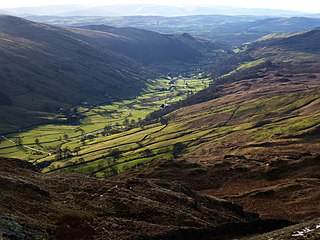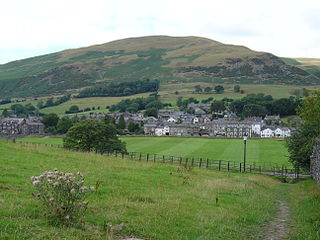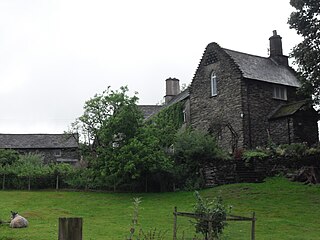
Peel towers are small fortified keeps or tower houses, built along the English and Scottish borders in the Scottish Marches and North of England, mainly between the mid-14th century and about 1600. They were free-standing with defence being a prime consideration of their design with "confirmation of status and prestige" also playing a role. They also functioned as watch towers where signal fires could be lit by the garrison to warn of approaching danger.

Longsleddale is a valley and civil parish in the South Lakeland district of the English county of Cumbria. It includes the hamlet of Sadgill. The parish has a population of 73. As the population taken at the 2011 Census was less than 100, details are maintained in the civil parish of Whitwell and Selside.

Sedbergh is a town and civil parish in Cumbria, England. The 2001 census gave the parish a population of 2,705, increasing at the 2011 census to 2,765. Historically in the West Riding of Yorkshire, it lies about 10 miles (16 km) east of Kendal, 28 miles (45 km) north of Lancaster and about 10 miles (16 km) north of Kirkby Lonsdale, just within the Yorkshire Dales National Park. It stands at the foot of Howgill Fells, on the north bank of the River Rawthey, which joins the River Lune 2 miles (3 km) below the town.

Brough Castle is a ruined castle in the village of Brough, Cumbria, England. The castle was built by William Rufus around 1092 within the old Roman fort of Verterae to protect a key route through the Pennine Mountains. The initial motte and bailey castle was attacked and destroyed by the Scots in 1174 during the Great Revolt against Henry II. Rebuilt after the war, a square keep was constructed and the rest of the castle converted to stone.

Great Salkeld is a small village and civil parish in the Eden District of Cumbria, England, a few miles to the north east of Penrith and bordering the River Eden. At the 2001 census the parish had a population of 445, decreasing to 412 at the 2011 Census.

Levens Hall is a manor house in the Kent valley, near the village of Levens and 5 miles (9 km) south of Kendal in Cumbria, Northern England.

High Head Castle is a large fortified manor house in the English county of Cumbria. It is located between Carlisle and Penrith. The house is now largely a ruin with the exterior walls and certain foundations surviving for the majority of the building. The right hand wing of the building has had a roof re-instated, and may be usable again for the first time since the building burnt down in the 1950s. It is currently not open to the public. It is privately owned, and the owners have now for some time been trying to restore it to its former glory.

Clifton Hall was a fortified manor house in the village of Clifton, Cumbria. Dating from around 1400, it was constructed by either Elianor Engaine or her son-in-law William Wybergh, and was held by the Wybergh family until the 19th century. Initially taking the form of an "H"-plan design built around a central hall, around 1500 a three-storey stone pele tower was added, providing both additional security and acting as a status symbol for the family. At the start of the 17th century a new stone hall was added to the south of the tower.

Burneside is a small village in South Lakeland in Cumbria, England. It is located to the north of Kendal and to the south east of Staveley, on the River Kent, just upstream from the confluence of the River Sprint. It has about 3,000 inhabitants. By the time of the 2011 Census Burneside had been transformed into an electoral ward only. The population of this ward was 1,888. The majority of the population are now recorded as living in Strickland Ketel parish.

Allithwaite is a small village in Cumbria, England, located roughly 1.2 miles (1.9 km) west of Grange-over-Sands. Most of its residents commute to local areas of Ulverston, Barrow-in-Furness, Kendal or Lancaster to work. Historically in Lancashire, Allithwaite, and the village of Cartmel situated to the north, are part of the civil parish of Lower Allithwaite. At the 2001 census, the parish had a population of 1,758, increasing to 1,831 at the 2011 Census. There is also a civil parish previously known as Upper Allithwaite which was renamed in 2018 as Lindale and Newton-in-Cartmel, and includes Lindale, Low Newton and High Newton. The population of this parish at the 2011 Census was 843.

St Gregory's Church, Vale of Lune, also known as the Vale of Lune Chapel, is a redundant Anglican church situated on the A684 road about 1.5 miles (2 km) to the west of Sedbergh, Cumbria, England. It is recorded in the National Heritage List for England as a designated Grade II listed building, and is under the care of the Churches Conservation Trust.

Burneside Hall is a converted medieval pele tower in Burneside, Cumbria, England.

Branthwaite Hall is pele tower in Cumbria, England, considered by historian Anthony Emery to be "one of the best-preserved early houses in Cumbria".

Duxbury Hall was a 19th-century country house in Duxbury Park estate in Duxbury Woods, Lancashire that has been demolished.

St Andrew's Church is in Main Street, Sedbergh, Cumbria, England. It is an active Anglican parish church in the deanery of Kendal, and the diocese of Carlisle. Its benefice is united with those of St Mark, Cautley, and St John the Baptist, Garsdale, to form the benefice of Sedbergh, Cautley and Garsdale. The church is recorded in the National Heritage List for England as a designated Grade I listed building.

Scaleby Castle is in the village of Scaleby, Cumbria, England. The castle was originally built in the early 14th century, and extended in the 15th century to form a substantial fortification. Parliamentary troops attacked the castle twice during the English Civil War, burning it. It was later restored to form a country house.
Sir John Sutherland Harmood-Banner, 1st Baronet was an English accountant from Liverpool. His interests spread across Lancashire and Cheshire, and extended to the British colonies and South America.

Alton Towers is located near the village of Alton in Staffordshire, England. The former country estate was a former seat of the Earls of Shrewsbury. It is now a major theme park in the United Kingdom. In 2012, it attracted 2.4 million visitors, making it the most visited theme park in the United Kingdom and 9th most visited theme park in Europe. It employs in excess of 2,000 staff members during the summer months.

Bispham Hall is a Grade II* listed Elizabethan country house in Billinge, now part of the Metropolitan Borough of Wigan, Greater Manchester.

Hollin Hall is a country house in Crook in Cumbria. It is a Grade II listed building.




















